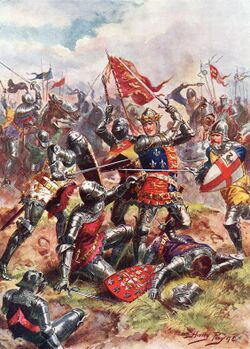Folly of Philip III
| Battle of Eastfleet | |||||||||||||||||||||||
|---|---|---|---|---|---|---|---|---|---|---|---|---|---|---|---|---|---|---|---|---|---|---|---|
| Part of the Urguani-Orenian War | |||||||||||||||||||||||
| |||||||||||||||||||||||
Following the successful Siege of Haverlock, the Imperial State Army took time to recover from the losses sustained during the siege while its leadership made preparations to advance into Urguani lands. As a result, Four of the Tripartite's Seven signatories quickly sent their armies to the Urguani borderlands in anticipation of the renewed Imperial offensive. After a long and brutal clash in the borderlands between Oren and Urguan, the Imperial State Army and its allies were forced back into Imperial lands, and the Tripartite emerged victorious in the Battle of Eastfleet.
Prelude
After the disastrous Siege of Haverlock, Tripartite forces withdrew from Lower Petra and re-entered Urguani lands. As a result of their victory, Emperor Philip III began planning a renewed offensive into Urguan in order to punish them and the other Tripartite signatories for refusing to sign a peace treaty that would end the war in Oren's favor. Yet, as planning went on, The Ferrymen were insulted by the Orenian populace's treatment of them and so deserted back to the Tripartite with no monetary costs.
This desertion, unexpected by both sides, greatly decreased the Emperor's available manpower and skilled warriors due to the Ferrymen being a sizeable organization and very well-trained in battle. Yet, Emperor Philip remained confident in the skills of his Imperial State Army and his vassals within the County of Blackvale. Blackvale itself had a very well-trained Levy, and many believed that their skills could counter the Ferrymen in combat.
Regardless, Emperor Philip ordered the mobilization of his soldiers towards the non-aligned border zone of Eastfleet, which served as a Monk controlled port that was freely accessible to anybody regardless of affiliation and sat right on the road between Urguan and Oren. Despite its non-aligned nature, Imperial soldiers had stationed themselves right outside the borderland in anticipation for a further push into Urguan. Once this was discovered by Urguani scouts, the Dwarven nation quickly sent letters to all members of the Tripartite Accord to warn them of the incoming attack. All signatories received and answered the call yet only the armies of Haense, Savoy, and Nevaehlen were capable of reaching the border with Eastfleet on time. While Norland and Krugmar did mobilize to join the Tripartite defense, Krugmar was too far for their warband to make it in time whilst Norland suffered logistical issues amongst its Ashguard and could not proceed. The Ferrymen, while available, were still situating themselves in Urguani lands and were unprepared to answer the call to arms yet.
Despite only having Four of the Seven signatory's armies present, the Tripartite Army still numbered roughly 18,100 Warriors. On the opposing side, the Imperial Army was not as numerous due to their loss of the Ferrymen, and so numbered around 11,700 Soldiers.
